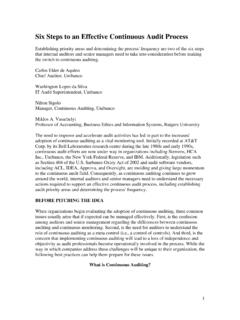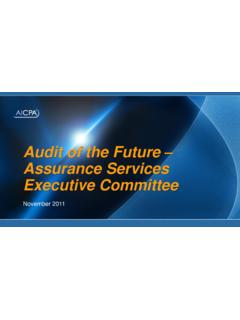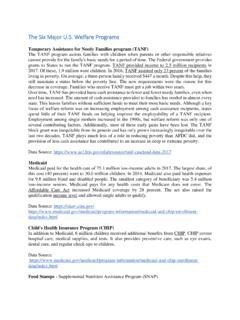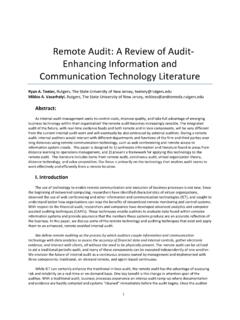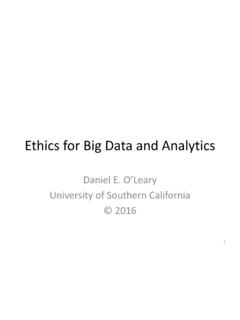Transcription of Continuous Controls Monitoring for Transactions: …
1 Research Publication Date: 15 January 2009 ID Number: G00164382. Continuous Controls Monitoring for transactions : The Next Frontier for GRC Automation French Caldwell, Paul E. Proctor Continuous Controls Monitoring for transactions (CCM-T) is an emerging governance, risk and compliance (GRC) technology that monitors ERP and financial application transaction Controls to improve financial governance and automate audit processes. CCM-T ensures that business rules and policies are effective, reduce compliance and audit costs, and support risk management. Key Findings CCM-T can produce a quick return on investment by identifying failures of internal Controls . CCM supports Continuous Monitoring (CM) and Continuous audit (CA). CCM solutions include segregation of duties (CCM-SOD), transaction Monitoring (CCM- T), master data (CCM-MD) and application configuration (CCM-AC).
2 Recommendations Consider CCM-T if any of the following goals apply: Lowering compliance costs A CCM-T solution can reduce the costs of audits by eliminating much manual sampling and minimizing the time it takes to gather documentation. Improving financial governance CCM-T can increase the reliability of transactional Controls , improve auditor trust and increase the effectiveness of anti-fraud Controls . Improving operational performance CCM-T Controls such as those that monitor duplicate payments, incorrect discounts or misapplied warranties go beyond what most people consider compliance. CCM-T can improve key processes and profitability. The following considerations are important when comparing the cost against savings and benefits: CCM is simplest and least expensive to apply in a homogeneous ERP environment for which the vendor has a preconfigured Controls library.
3 When financial processes are spread across multiple instances, and especially when there is a mix of ERP financial applications and/or other non-ERP financial applications, large amounts of customization will add significant expense. However, CCM potentially could be used to mitigate the need to move to centralized financial systems in ERP, and 2009 Gartner, Inc. and/or its Affiliates. All Rights Reserved. Reproduction and distribution of this publication in any form without prior written permission is forbidden. The information contained herein has been obtained from sources believed to be reliable. Gartner disclaims all warranties as to the accuracy, completeness or adequacy of such information. Although Gartner's research may discuss legal issues related to the information technology business, Gartner does not provide legal advice or services and its research should not be construed or used as such.
4 Gartner shall have no liability for errors, omissions or inadequacies in the information contained herein or for interpretations thereof. The opinions expressed herein are subject to change without notice. costs of customization should be balanced against what it would cost to migrate to a single ERP system. Publication Date: 15 January 2009/ID Number: G00164382 Page 2 of 8. 2009 Gartner, Inc. and/or its Affiliates. All Rights Reserved. WHAT YOU NEED TO KNOW. Financial processes have many business rules and policies (that is, Controls ) governing transactions that are well suited for automation. ERP financial applications enable automation of Controls , but not their automated Monitoring . CCM technologies are applied automatically and periodically to monitor the automated Controls for processes that are repeatable, consistent and predictable.
5 CCM-T can produce a financial return on investment by identifying exceptions or failures of internal Controls for transactions , which in turn may be due to operational deficiencies or control gaps. ANALYSIS. Technology Description Critical financial processes such as travel expense management, order to cash and procure to pay have many business rules or policies associated with them that address accounting, reliability and anti-fraud issues. To ensure that policies and rules are followed, many ERP and financial applications have built-in internal Controls with simple gated logic (see Note 1 for an example of an internal control ). However, the existence of these built-in automated Controls does not ensure that they are turned on, that they are configured appropriately, and that they are not regularly overridden or bypassed thus establishing the need for a solution that can monitor these Controls .
6 Continuous Controls Monitoring Continuous Controls Monitoring (CCM) is a set of technologies to assist the business in reducing business losses through Continuous Monitoring and reducing the cost of auditing through Continuous audit of the Controls in financial applications. CCM technologies are applied automatically and periodically to support processes that are repeatable, consistent and predictable. CCM technologies fall within the GRC marketplace. For more information on the GRC. marketplace, see "A Comparison Model for the GRC Marketplace, 2008 to 2010." CCM is a subset of a broader set of technologies called " Controls automation and Monitoring " (see Note 2), which includes infrastructure, systems and other application Controls . They have also been referenced as " Controls - Monitoring analytic applications" in the broader packaged financial application market (see "Leveraging Financial Analytics").
7 CCM for transactions This research addresses CCM for transactions ; however, customer requirements often require CCM solutions that have capabilities in multiple CCM subsegments. Besides CCM-T, the other subsegments are CCM for segregation of duties, CCM for master data and CCM for application configuration (see Note 3 for definitions of the subsegments). CCM-T provides for broader visibility into all transactions , eliminating the need for manual sampling of transactions . The traditional method to monitor that policies and rules are being followed is manual sampling of transactions . However, manual sampling is labor-intensive, is expensive, lacks timeliness, represents a tiny fraction of the transactions and will often not find a singular event such as a single instance of fraud.
8 CCM-T solutions often are based on the same technology as audit analytics software which is the tool used by auditors during the course of periodic audits to run either standard or ad hoc Publication Date: 15 January 2009/ID Number: G00164382 Page 3 of 8. 2009 Gartner, Inc. and/or its Affiliates. All Rights Reserved. queries against sets of transactional data. Essentially, CCM-T is audit analytics preconfigured with a set of standard queries that are run in batch mode on a frequent, near-real-time basis . often nightly. Technology Definition CCM-T software analyzes ERP and other financial application transactions to identify exceptions to policies, business rules and built-in application Controls . CCM-T software can also be used to establish Controls as well as monitor them.
9 CCM-T software has several functions, including transaction Monitoring , exception and remediation management, reporting and analytics, and workflow: Transaction Monitoring functions automatically, periodically imports transaction data from ERP and financial applications, and applies a set of predefined audit analytics to identify control exceptions. Exception and remediation management supports tracking the response to identified control failures and other deficiencies, along with the process of addressing exceptions. Reporting and analytics supports trending and audit analysis, audit trails, dashboards, and the generation of reports. Workflow supports the notifications and alerts, reviews, approvals, and other process automation needs. Uses When implementing CCM-T, most organizations start with the procure-to-pay process.
10 Procure to pay is a focus for anti-fraud, and it also provides an opportunity for immediate return on investment by reducing, for example, payment of duplicate invoices. Next steps can include travel and entertainment (T&E) and order-to-cash processes. CCM-T and the other CCM subsegments support both Continuous Monitoring for management and Continuous audit for internal auditors: Continuous Monitoring is a business management Monitoring function used to ensure that Controls operate as designed and that transactions are processed appropriately. CM. uses control automation to reduce fraud and improve financial governance, typically resulting in an immediate return on investment. It improves the reliability of the Controls and improves the management oversight, policy enforcement and operational efficiency for critical financial processes (see "Q&A on Financial Governance Market Trends"), often producing hard-dollar savings.
